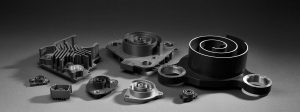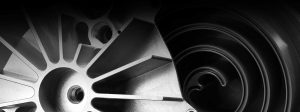Air Squared Articles
Air Compressor Testing Method
Standard method for testing Air Squared scroll air compressors.
Air Squared uses NIST-calibrated equipment for all testing practices. For open-loop (air) testing, the test bench is assembled as shown in Figure 1. Arrows represent the flow of gas through the system, starting at the discharge of the compressor. For closed-loop testing with gases other than air, contact Air Squared to discuss test bench requirements.

Test Stand
Required materials for a scroll compressor test stand are:
- Flow Meter
- Amp Meter
- Multimeter or Volt Meter
- Pressure Gauge
- Pressure Control Valve
- Tachometer or Rate Meter
- Laser Thermometer
- Cooling Fan
- Performance Datasheet
Reference a detailed scroll compressor test bench schematic using the following link:
Air Compressor Test Bench Schematic
Measurements
Standard recorded measurements are: date, time, motor speed, discharge pressure, discharge temperature, ambient pressure, ambient temperature, flow rate (downstream of valve – see schematic), voltage, and current.
Flow
Air Squared publishes inlet volume flow at NIST standard ambient conditions. Although there is variance among compressor manufacturers, most publish inlet volume flow at standard conditions, as opposed to discharge flow.
Air Squared publishes compressor flow in liters per minute (lpm) or cubic feet per minute (cfm). The industry also references standard liters per minute (slpm) or standard cubic feet per minute (scfm). This means the flow rate is corrected for NIST standard temperature and pressure (STP) – 101.325kPa and 293.15 Kelvin. The equation for correction is shown in Figure 2.

Air Squared considers a volume flow rate reported at standard conditions (slpm or scfm) a mass flow rate. Technically speaking, a standard flow rate (slpm or scfm) is a volume flow rate (lpm or cfm), albeit one corrected to STP. However, at STP, the fluid density is known, so the mass flow rate is easily calculated. Thus, standard volume flow rate and mass flow rate are used interchangeably, and the meaning is still understood. Regarding units, volume per time is always a volume flow rate and mass per time is always a mass flow rate, but standard volume per time can be referenced as either volume flow at STP or mass flow (as density is known at STP).

Air Squared measures flow using a mass flow meter. A mass flow meter is superior to a rotameter, as a rotameter is typically calibrated to a specific condition (primarily STP), and any significant deviation from that condition greatly reduces accuracy. The ambient pressure in Thornton, CO, is much lower than standard ambient pressure, so a rotameter calibrated to STP is ineffective.
There is generally a pressure drop across the flow meter, so it is placed downstream from the pressure control valve. To account for this, any flow rate, measured as a discharge flow rate, is corrected using the actual inlet temperature and pressure. See the equation shown in Figure 3.
Power Consumption
Motor power consumption is measured using a multimeter (voltage) and an amp meter (current) as close to the motor as possible. With brushless DC motors (BLDC), it is best measured at the appropriate motor leads between the controller and the motor.
Speed
Speed is measured either manually using a tachometer directly on the motor shaft or an available bearing, or electronically using an RPM gauge that counts the motor pulses.
Temperature
Gas temperatures are measured using fluid thermocouples. Surface temperatures are measured using a laser thermometer on the front face of the compressor, as close to the discharge port as possible (location of maximum temperature).
Operation
Compression is an exothermic process, with excess heat managed using a cooling fan (or liquid cooling) to force convection. Air Squared always recommends the use of additional cooling when available.
Data points are measured and recorded only after the compressor has achieved steady-state temperature. Steady-state temperature is dependent on the local environment, so steady-state is assumed to use the standard cooling fan and ambient conditions in Thornton, CO, at the time of testing. Steady-state temperature is confirmed by measuring the surface temperature of the compressor, at the same location, in periodic intervals until the temperature is constant.
Altitude
Air Squared is located in Thornton, CO – 1,631 meters (5,351 feet) above sea level. The atmospheric pressure at this altitude is approximately 0.835 bara (12.1 psia). All Air Squared air compressors are tested at this altitude, so the atmospheric pressure differential between Thornton, CO, and sea level should be considered.
For compressors at a given pressure and speed, the lower air density in Thornton, CO, can result in lower power consumption and a lower flow rate than testing at sea level.





